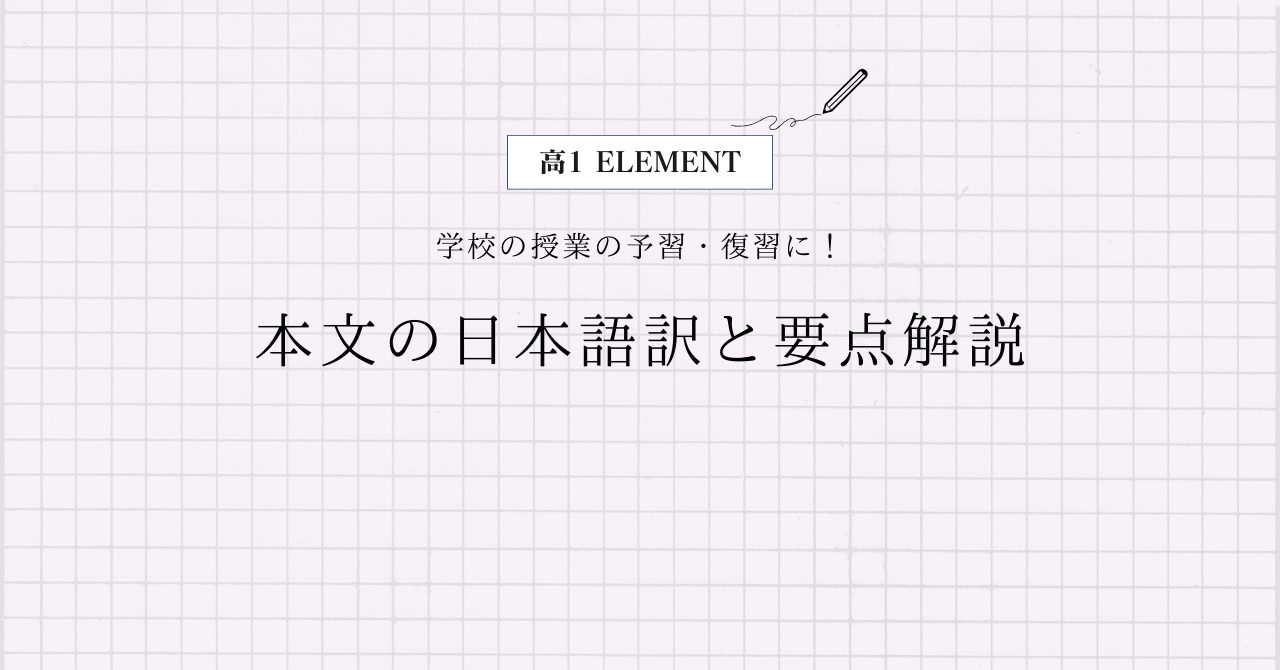三省堂 高1ELEMENT Lesson6 Section1の本文の日本語訳と重要箇所の解説です。
Lesson6-2, 6-3, 6-4の解説はこちらからご覧ください。
>高1ELEMENT Lesson6 Section2 本文和訳
>高1ELEMENT Lesson6 Section3 本文和訳
>高1ELEMENT Lesson6 Section4 本文和訳
- ELEMENT Lesson6 Section1 本文と日本語訳
- ELEMENT Lesson6 Section1 重要事項の解説
- The Power of Words
- “I would like to thank you so much for giving me the Hans Christian Andersen Award.
- Shortly after World War II, IBBY founder Jella Lepman worked hard to create world peace through children’s literature.
- I deeply admire her hard work.
- I was a 10-year-old girl in the middle of the war.
- In that desperate time, books gave me courage to live.
- For this reason, this award holds a very special meaning for me.”
- In 2018, children’s book author Kadono Eiko won the IBBY Hans Christian Andersen Award, which is often called the Nobel Prize for children’s literature.
- At the ceremony, she talked about how books helped her in her childhood.
- She also shared some onomatopoeia such as donburakok-ko-oh, suk, kok-ko-oh.
- When she was a child, she cried often because her mother had died.
- To calm her, her father told a tale that began with these sounds.
- “A great peach came donburakok-ko-oh, suk, kok-ko-oh floating down the river.”
- ELEMENT Lesson6 Section1 まとめ
ELEMENT Lesson6 Section1 本文と日本語訳
The Power of Words
「言葉の力」
“I would like to thank you so much for giving me the Hans Christian Andersen Award.
『国際アンデルセン賞を頂いたことにとても感謝したいです。』
Shortly after World War II, IBBY founder Jella Lepman worked hard to create world peace through children’s literature.
『第二次世界大戦の直後に、国際児童図書評議会の創設者であるイェラ・レップマンが、児童文学を通して世界平和を創るために一生懸命取り組みました。』
I deeply admire her hard work.
『私は彼女の熱心な取り組みに深く感心しています。』
I was a 10-year-old girl in the middle of the war.
『戦争の最中、私は10歳の少女でした。』
In that desperate time, books gave me courage to live.
『そんな絶望的な時に、本が私に生きる勇気をくれました。』
For this reason, this award holds a very special meaning for me.”
『この理由から、この賞は私にとってとても特別な意味を持っています。』
In 2018, children’s book author Kadono Eiko won the IBBY Hans Christian Andersen Award, which is often called the Nobel Prize for children’s literature.
「2018年、児童書の作者である角野英子さんは、しばしば児童文学のノーベル賞と呼ばれる国際児童図書評議会の国際アンデルセン賞を受賞しました。」
At the ceremony, she talked about how books helped her in her childhood.
「その式典で、彼女は本がどのようにして幼少期に自分を助けてくれたのかを話しました。」
She also shared some onomatopoeia such as donburakok-ko-oh, suk, kok-ko-oh.
「また、彼女はどんぶらこっこ、すっこっこのような擬音語もいくつか共有しました。」
When she was a child, she cried often because her mother had died.
「彼女は子どものとき、母親が亡くなっていたのでよく泣いていました。」
To calm her, her father told a tale that began with these sounds.
「彼女を落ち着かせるために、父親はこの音で始まる物語を話していました。」
“A great peach came donburakok-ko-oh, suk, kok-ko-oh floating down the river.”
『大きな桃がどんぶらこっこ、すっこっこと川に流されながらやって来ました。』

ELEMENT Lesson6 Section1 重要事項の解説
The Power of Words
“power”は「力、権力」、“word”は「言葉、単語」といった名詞、“of”は前置詞で、”A of B”の形で「BのA」というように後ろから前に訳します。
“I would like to thank you so much for giving me the Hans Christian Andersen Award.
“would like”は“want”と同じ「が欲しい」という意味で,“would like to 動詞の原形”で「~したい」という重要表現になります。
“thank”は「に感謝する」という動詞で、“thank 人 for~”で「人に~を感謝する」という表現になります。
“for”は前置詞なので、“giving”は「動名詞」になっていますね。“so much”は「とても」といった副詞表現です。
“give 人 もの”で「人にものをあげる」となって,“give もの to 人”でも同じ意味になります。
“the Hans Christian Andersen Award”は「国際アンデルセン賞」という名詞ですね。
Shortly after World War II, IBBY founder Jella Lepman worked hard to create world peace through children’s literature.
“shortly after~”は「~の直後」という前置詞表現です。
“World War II”は「第二次世界大戦」、“IBBY”は「国際児童図書評議会」、“founder”は「創設者、創立者」という名詞になりますね。
“work”は「働く、取り組む」という動詞で、“hard”は「一生懸命に」という副詞です。
“create”は「を創造する、創る」という動詞で、ここでは“to”が付いて「不定詞の副詞的用法」になっています。
“peace”は「平和」、“literature”は「文学」という名詞で、“through”は「~を通して」という前置詞ですね。
また、名詞に‘sを付けると「~の」という所有を表します。
直前の名詞が複数形のときは” teachers‘ “のようにアポストロフィーだけを最後に付けます。
I deeply admire her hard work.
“deeply”は「深く」という副詞です。
“admire”は「を称賛する、に感心する」という動詞で、“hard”は「熱心な、大変な」といった形容詞、“work”は「仕事、取り組み」という名詞ですね。
I was a 10-year-old girl in the middle of the war.
“数字 – 単位”で1つの形容詞をつくることができます。このとき「単位」は単数形にします。
“in the middle of~”は「~の最中に、~の真ん中に」という表現で、“war”は「戦争」という名詞になります。
In that desperate time, books gave me courage to live.
“that”は「そんな」という副詞、“desperate”は「絶望的な」という形容詞です。
“courage”は「勇気」という名詞で、“to live”が「不定詞の形容詞的用法」になって“courage”を修飾していますね。
For this reason, this award holds a very special meaning for me.”
“for this reason”で「この理由から」という表現です。
“hold a meaning for~”で「~にとって意味を持つ」という表現になります。
“award”は「賞」、“meaning”は「意味」という名詞で、“special”は「特別な」という形容詞ですね。
In 2018, children’s book author Kadono Eiko won the IBBY Hans Christian Andersen Award, which is often called the Nobel Prize for children’s literature.
“autho”は「作者、著者」という名詞で、“won”は“win(に勝つ、受賞する)”の過去形です。発音は「ワン」なので要注意ですよ!
“which”は「主格の関係代名詞」ですが、カンマが付いているので「非制限用法」で、“which is often called the Nobel Prize for children’s literature”が先行詞“the IBBY Hans Christian Andersen Award”を修飾しています。
「非制限用法」は名詞の補足説明をしたいときに使います。訳すときはふつう前から順に訳していきますが、今回は訳す順番を入れ替えています。
“often”は「しばしば、よく」という副詞ですね。また、文も「受動態」になっています。
“the Nobel Prize”は「ノーベル賞」ですね。
At the ceremony, she talked about how books helped her in her childhood.
“ceremony”は「式典、儀式」という名詞です。
“how books helped her in her childhood”は「間接疑問文」になっていますね。
“childhood”は「幼少期、子ども時代」といった名詞です。
She also shared some onomatopoeia such as donburakok-ko-oh, suk, kok-ko-oh.
“also”は「また,さらに」といった副詞で,付け加える役割があります。色々な文で使うので必ず覚えましょう!
“share”は「を共有する、分け合う」といった動詞で、“some”は「いくつかの」という形容詞、“onomatopoeia”は「擬音語、オノマトペ」という不可算名詞です。
“some”は不可算名詞にも使うことができますよ!
“such as~”は「~のような、~など」という重要表現ですね。
“donburakok-ko-oh“は「どんぶらこっこ」、“suk, kok-ko-oh“は「すっこっこ」でOKです。
When she was a child, she cried often because her mother had died.
ここでは「接続詞when」と「接続詞because」が使われていますね。
“cry”は「泣く、叫ぶ」、“die”は「死ぬ」という動詞です。
“had died”は「過去完了形」になっていて、「母親はすでに亡くなっていた」→「よく泣いていた」という過去の出来事の順序を明確にしていますね。
To calm her, her father told a tale that began with these sounds.
“calm”は「を落ち着かせる、静かにさせる」という動詞で、“To calm”は「不定詞の副詞的用法」になっていますね。
“tale”は「(空想の)話、物語」という名詞で、“tell a tale”で「物語を話す」という意味です。
“that”は「主格の関係代名詞」で、“that began with these sounds”が先行詞“a tale”を修飾しています。
“began”は“begin(を始める、が始まる)”の過去形で、“begin with~”で「~で始まる」という意味になります。
“these”は“this”の複数形で,「これらは(の)」といった意味、“sound”は「音」という名詞ですね。
“A great peach came donburakok-ko-oh, suk, kok-ko-oh floating down the river.”
“peach”は「桃」という名詞ですね。
この文は「分詞構文」になっていて、“A great peach came donburakok-ko-oh, suk, kok-ko-oh and it is floating down the river.”が元々の文です。
この文の接続詞”and”と主語の”it”、そして”is”が省略されているわけですね。
2つの動作が同時に起きているので、「~しながら」と訳してあげましょう。
“float down the river”は「川を下る、川に流される」という意味になります。
ELEMENT Lesson6 Section1 まとめ
以上がELEMENT Lesson6 Section1の日本語訳となります。
「関係代名詞」「分詞構文」などの使い方をしっかり確認しておきましょう!
>高1ELEMENT Lesson6 Section2 本文和訳
>高1ELEMENT Lesson6 Section3 本文和訳
>高1ELEMENT Lesson6 Section4 本文和訳
何か分からない点や他に解説してほしい点があれば,お気軽にコメントしてください!


コメント